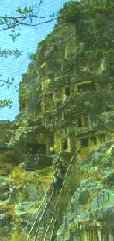 Myra features some of the most impressive and well preserved Lycian monuments in the country. These include an excellent collection of rock tombs and an imposing 2nd century theater.
Myra features some of the most impressive and well preserved Lycian monuments in the country. These include an excellent collection of rock tombs and an imposing 2nd century theater.
Many of the tombs have log cabin features carved into the rock, presumably reflecting the domestic architecture of the period. A few easily accessible ones have inscriptions in the Lycian language. Carvings above are mostly in poor repair but the overall effect of this jumble of the architecture of death is dramatic.
The theater, like many others in major Roman cities, was later converted into an arena for gladiator fights and wild animal shows. Many carvings and inscriptions in the theater are still visible, and cavernous tunnels and access ways to the side have been cleared. While much of the seating is intact, the stage building is partly collapsed. A macabre set of three carved masks, presumably from the frieze, lies among the jumble of remains in the approach to the theater.
Today the ruins of Myra ancient site are located in Demre town on the Mediterranean coast of Anatolia. Nearby there are Andriake on Çayagzi beach and Kekova sunken city, Simena and Teimussa sites which are accessible by a short boat ride or driving.

